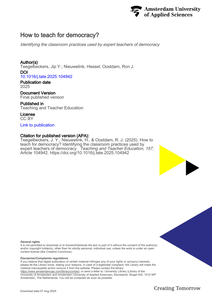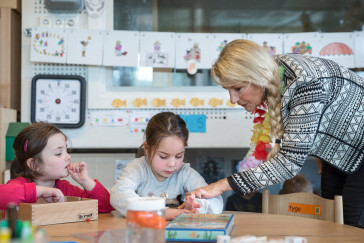Background: A large number of people participate in individual or unorganized sports on a recreational level. Furthermore, many participants drop out because of injury or lowered motivation. Potentially, physical activity–related apps could motivate people during sport participation and help them to follow and maintain a healthy active lifestyle. It remains unclear what the quality of running, cycling, and walking apps is and how it can be assessed. Quality of these apps was defined as having a positive influence on participation in recreational sports. This information will show which features need to be assessed when rating physical activity–related app quality. Objective: The aim of this study was to identify expert perception on which features are important for the effectiveness of physical activity–related apps for participation in individual, recreational sports. Methods: Data were gathered via an expert panel approach using the nominal group technique. Two expert panels were organized to identify and rank app features relevant for sport participation. Experts were researchers or professionals in the field of industrial design and information technology (technology expert panel) and in the field of behavior change, health, and human movement sciences who had affinity with physical activity–related apps (health science expert panel). Of the 24 experts who were approached, 11 (46%) agreed to participate. Each panel session consisted of three consultation rounds. The 10 most important features per expert were collected. We calculated the frequency of the top 10 features and the mean importance score per feature (0-100). The sessions were taped and transcribed verbatim; a thematic analysis was conducted on the qualitative data. Results: In the technology expert panel, applied feedback and feedforward (91.3) and fun (91.3) were found most important (scale 0-100). Together with flexibility and look and feel, these features were mentioned most often (all n=4 [number of experts]; importance scores=41.3 and 43.8, respectively). The experts in the health science expert panels a and b found instructional feedback (95.0), motivating or challenging (95.0), peer rating and use (92.0), motivating feedback (91.3), and monitoring or statistics (91.0) most important. Most often ranked features were monitoring or statistics, motivating feedback, works good technically, tailoring starting point, fun, usability anticipating or context awareness, and privacy (all n=3-4 [number of experts]; importance scores=16.7-95.0). The qualitative analysis resulted in four overarching themes: (1) combination behavior change, technical, and design features needed; (2) extended feedback and tailoring is advised; (3) theoretical or evidence base as standard; and (4) entry requirements related to app use. Conclusions: The results show that a variety of features, including design, technical, and behavior change, are considered important for the effectiveness of physical activity–related apps by experts from different fields of expertise. These insights may assist in the development of an improved app rating scale.
LINK
To stimulate democratic competences through teaching, it is necessary to have an understanding of actions and behaviors that are considered effective in teaching methods. In this study, we investigated these actions and behaviors, referred to as classroom practices, by interviewing 20 expert teachers of democracy in the Netherlands. We identified six relevant practices: meaningful embedding, providing multiple perspectives, thinking about solutions from divergent perspectives, independent information collection and presentation, taking socio-political action, and critical reflection on subject matter. We show how these practices are associated with democratic competences and provide examples of how the practices are implemented in teaching methods.
DOCUMENT

This report presents the highlights of the 7th European Meeting on Molecular Diagnostics held in Scheveningen, The Hague, The Netherlands, 12-14 October 2011. The areas covered included molecular diagnostics applications in medical microbiology, virology, pathology, hemato-oncology,clinical genetics and forensics. Novel real-time amplification approaches, novel diagnostic applications and new technologies, such as next-generation sequencing, PCR lectrospray-ionization TOF mass spectrometry and techniques based on the detection of proteins or other molecules, were discussed. Furthermore, diagnostic companies presented their future visions for molecular diagnostics in human healthcare.
DOCUMENT

Diverse partijen, zowel marktpartijen als kennisinstellingen, gaan in 2020 samenwerken in een pilot om te toetsen in hoeverre zij de plant kardoen (familie van de artisjok distel) in haar volle potentieel kunnen gebruiken voor diverse commerciële doeleinden, zoals bloemen, voedsel, composiet en een lamp. Er wordt in deze pilot onderzoek gedaan naar: - Gebruik van reststromen als bodemverbeteraar - Teelt van kardoen - Verwerking van kardoen
Hoe zou de wereld er uitzien als de samenwerking tussen school en Veilig Thuis perfect zou zijn? In het bijzonder voor kinderen die het zwaar te verduren hebben door verwaarlozing, misbruik of mishandeling?

Hoe zou de wereld er uitzien als de samenwerking tussen school en Veilig Thuis perfect zou zijn? In het bijzonder voor kinderen die het zwaar te verduren hebben door verwaarlozing, misbruik of mishandeling?Doel In dit onderzoek gaan we na wat de belemmerende en bevorderende factoren bij leerkrachten in het primair onderwijs zijn in hun aanpak van kindermishandeling (denk aan signaleren, melden en het toepassen van de verplichte Meldcode huiselijk geweld en kindermishandeling). Ook onderzoeken we het resultaat van een korte interventie waarbij een Veilig Thuis medewerker een gesprek heeft met de leerkracht over diens knelpunten bij deze aanpak. Daarbij gaan we na of deze aanpak de duur van wel gemelde kindermishandeling kan verkorten. Resultaten Inzicht in de verbeterpunten in de samenwerking tussen Veilig Thuis en primair onderwijs bij het signaleren en melden van (vermoedens van) kindermishandeling. Aanbevelingen aan beleidsmakers, jeugdprofessionals en opleidingen. Publicatie in vakblad voor professionals in het primair onderwijs. Publicatie in een wetenschappelijk tijdschrift Looptijd 01 september 2020 - 01 mei 2022 Aanpak Een medewerker van Veilig Thuis spreekt met de leerkracht op school over de knelpunten die deze leerkracht (of school) ervaart. De bevindingen worden in elk van de betreffende regio’s besproken met de belanghebbende ketenpartners. Ook wordt een bovenregionale expertmeeting gehouden waarin naast de resultaten ook de economische aspecten van deze samenwerking tegen het licht gehouden worden.